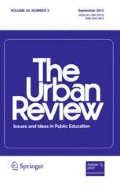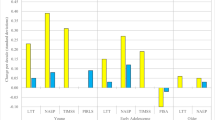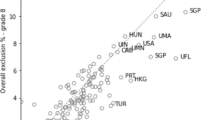Abstract
The hypothesis of acting White has been heatedly debated and influential over the last 20 years or so in explaining the Black–White test score gap. Recently, economists have joined the debate and started providing new theoretical and empirical analyses of the phenomenon. This paper critically reviews the arguments that have been advanced to support and refute the hypothesis. This review particularly covers the analyses in economics because the economic analyses are relatively new and usually neglected in other disciplines. Also, nationally representative data are emphasized, whenever possible, to improve the generalizability of the arguments. This review concludes that although the analyses in both non-economics and economics are thought-provoking and compelling in some respect, a substantial body of empirical evidence is inconsistent with the assumptions of and results from the analyses.
Similar content being viewed by others
Notes
From a recent randomized experiment, the Moving to Opportunity, Sanbonmatsu et al. (2007) find that moving to a better neighborhood improves little, if any, Black students’ educational outcomes and attitudes toward school. The results are in contrast to the previous results from a quasi-experiment, the Gautreaux Program (Rosenbaum 1995).
The student sorting by academic achievement among Black students is not as clear as that among White and Asian students.
Cook and Ludwig (1998) adopt five measures of low standing: feels put down by students, threatened at least once last fall, not popular, not part of leading crowd, and not popular with opposite sex. They find only the last measure is statistically significant between predominantly White schools and predominantly Black schools. They define a predominantly White school is as a school where at least 60 percent of the total student population is non-Hispanic White. An analogous definition is applied to the definition of predominantly Black schools. And yet, when Farkas et al. (2002) focus on the first measure only (“feels put down by students”) and use a different definition of predominantly Black schools (schools with less than 25 percent White students), they find a statistically significant negative relationship between the measure of popularity and being Black. These two inconsistent results point out that the relationship between popularity and academic achievement among Black students is sensitive to measures of popularity and definitions of Black/White schools (or segregated/integrated schools) used in the estimation.
The initial immigrant took place between 1850 and 1882 for Chinese immigrants and between 1890 and 1924 for Japanese immigrants. The Chinese Exclusion Act of 1882 forbade Chinese immigration until the law was repealed in 1943. The “Gentleman’s Agreement” of 1907 had limited, and the immigration act of 1924 had terminated Japanese immigration until the McCarran-Walter Act of 1952 allowed naturalization privileges to Japanese immigrants.
References
Acemoglu, D. (2002). Technical change, inequality, and the labor market. Journal of Economic Literature, 40(1), 7–72.
Ainsworth-Darnell, J. W., & Downey, D. B. (1998). Assessing the oppositional culture explanation for racial/ethnic differences in school performance. American Sociological Review, 63(4), 536–553.
Akerlof, G. A., & Kranton, R. E. (2002). Identity and schooling: Some lessons for the economics of education. Journal of Economic Literature, 40(4), 1167–1201.
Anderson, J. D. (1988). The education of blacks in the South, 1860–1935. Chapel Hill, NC: University of North Carolina.
Armor, D. J. (1992). Why is black educational achievement rising? Public Interest, 108, 65–80.
Armor, D. J. (1995). Forced justice: School desegregation and the law. Oxford, UK: Oxford University Press.
Austen-Smith, D., & Fryer, R. G. (2005). An economic analysis of “acting white”. Quarterly Journal of Economics, 120(2), 551–583.
Autor, D. H., Katz, L. F., & Kearney, M. S. (2008). Trends in U.S. wage in equality: Revising the revisionists. Review of Economics and Statistics, 90(2), 300–323.
Autor, D. H., Katz, L. F., & Krueger, A. B. (1998). Computing inequality: Have computers changed the labor market? Quarterly Journal of Economics, 113(4), 1169–1213.
Bartlett, L., & Brayboy, B. M. J. (2005). Race and schooling: Theories and ethnographies. Urban Review, 37(5), 361–374.
Bergin, D. A., & Cooks, H. C. (2002). High school students of color talk about accusations of “acting White”. Urban Review, 34(2), 113–134.
Betts, J. R. (1996). What do students know about wages?: Evidence from a survey of undergraduates. Journal of Human Resources, 31(1), 27–56.
Brown, B. B., & Steinber, L. (1991). Final report: Project 2. Noninstructional influences on adolescent engagement and achievement. Washington, DC: Office of Educational Research and Improvement.
Burtless, G. (Ed.). (1996). Does money matter?: The effect of school resources on student achievement and adult success. Washington, DC: Brookings Institution.
Coleman, J. S. (1961). The adolescent society: The social life of the teenager and its impact on education. New York: The Free Press.
Cook, P. J., & Ludwig, J. (1998). The burden of acting white: Do black adolescents disparage academic achievement? In C. Jencks & M. Phillips (Eds.), The black–white test score gap (pp. 375–400). Washington, DC: Brookings Institution.
Cookson, P. W., & Persell, C. H. (1985). Preparing for power: America’s elite boarding schools. New York: Basic Books.
Downey, D. B., & Ainsworth-Darnell, J. W. (2002). The search for oppositional culture among black students. American Sociological Review, 67(1), 156–164.
Eckert, P. (1989). Jocks & burnouts: Social categories and identity in the high school. New York: Teachers College Press.
Farkas, G., Lleras, C., & Maczuga, S. (2002). Does oppositional culture exist in minority and poverty peer groups? American Sociological Review, 67(1), 148–155.
Fordham, S. (1988). Racelessness as a factor in black students’ school success: Pragmatic strategy or pyrrhic victory. Harvard Educational Review, 58(1), 54–84.
Fordham, S. (1996). Blacked out: Dilemmas of race, identity and success at Capital High. Chicago: University of Chicago Press.
Fordham, S., & Ogbu, J. U. (1986). Black students’ school success: Coping with the “burden of ‘acting white’”. Urban Review, 18(3), 176–206.
Frazier, E. F. (1957). Black bourgeoisie: The rise of a new middle class in the United States. New York: Free Press.
Fryer, R. G. (2006). Acting white: The social price paid by the best and brightest minority students. Education Next, 6(1), 53–59.
Fryer, R. G., & Levitt, S. D. (2004). Understanding the black–white test score gap in the first two years of school. Review of Economics and Statistics, 86(2), 447–464.
Fryer, R. G., & Levitt, S. D. (2006). The black–white test score gap through third grade. American Law and Economics Review, 8(2), 249–281.
Fryer, R. G., & Torelli, P. (2005). An empirical analysis of ‘acting white’. NBER Working Paper 11334. Cambridge, MA: National Bureau of Economic Research.
Graham, A., & Anderson, K. A. (2008). “I have to be three steps ahead”: Academically gifted African American male students in an urban high school on the tension between an ethnic and academic identity. Urban Review, 40(5), 472–499.
Gregory, S. S. (1992, March 16). The hidden hurdle. Time, 44–46.
Hauser, R. M., & Anderson, D. K. (1991). Post-high school plans and aspirations of black and white high school seniors: 1976–86. Sociology of Education, 64(4), 263–277.
Heckman, J. J. (1998). Detecting discrimination. Journal of Economic Perspectives, 12(2), 101–116.
Hedge, L. V., & Nowell, A. (1998). Black–white test score congruence since 1965. In C. Jencks & M. Phillips (Eds.), The black–white test score gap (pp. 149–181). Washington, DC: Brookings Institution.
Hemmings, A. (1996). Conflicting images? Being black and a model high school student. Anthropology & Education Quarterly, 27(1), 20–50.
Hill, R. (1990, May 18). Lesson to learn: Bad grades aren’t cool: Montgomery black groups holding festival to sell minority students on achievement. Washington Post, D1.
Hirschman, C., & Wong, M. G. (1986). The extraordinary educational attainment of Asian-American: A search for historical evidence and explanations. Social Forces, 65(1), 1–27.
Hovart, E. M., & Lewis, K. S. (2003). Reassessing the “burden of ‘acting white’”: The importance of peer groups in managing academic success. Sociology of Education, 76(4), 265–280.
Jencks, C., & Phillips, M. (Eds.). (1998). The black–white test score gap. Washington, DC: Brookings Institution.
Jones, K. A. (2005). Oreos, coconuts, apples, and bananas: The problem of racial self-identification amongst young people of color. Rutgers Race & the Law Review, 7(1), 149–184.
Kao, G., & Tienda, M. (1998). Educational aspiration of minority youth. American Journal of Education, 106, 349–384.
Lee, J. (2002). Racial and ethnic achievement gap trends: Reversing the progress toward equity? Educational Researcher, 31(1), 3–12.
McArdle, C. G., & Young, N. F. (1970). Classroom discussion of racial identity or how can we make it without “acting white”? American Journal of Orthopsychiatry, 40(1), 135–141.
Miron, L. F., & Lauria, M. (1998). Student voice as agency: Resistance and accommodation in inner-city schools. Anthropology & Education Quarterly, 29(2), 189–213.
Murnane, R. J., Willett, J. B., & Levy, F. (1995). The growing importance of cognitive skills in wage determination. Review of Economics and Statistics, 77(2), 251–266.
Nasir, N. S., McLaughlin, M. W., & Jones, A. (2009). What does it mean to be African American?: Constructions of race and academic identity in an urban public high school. American Educational Research Journal, 46(1), 73–114.
Neal, D. (2006). Why has black–white skill convergence stopped? In E. Hanushek & F. Welch (Eds.), Handbook of the economics of education (Vol. 1, pp. 511–576). New York: Elsevier.
Neal, D. A., & Johnson, W. R. (1996). The role of premarket factors in black–white wage differences. Journal of Political Economics, 104(5), 869–895.
Ogbu, J. U. (1974). The next generation: An ethnography of education in an urban neighborhood. New York: Academic Press.
Ogbu, J. U. (2003). Black American students in an affluent suburb: A study of academic disengagement. Mahwah, NJ: L. Erlbaum.
Ogbu, J. U. (2004). Collective identity and the burden of “acting white” in black history, community, and education. Urban Review, 36(1), 1–35.
Peterson-Lewis, S., & Bratton, L. M. (2004). Perceptions of “acting Black” among African American teens: Implications of racial dramaturgy for academic and social achievement. Urban Review, 36(2), 81–100.
Petroni, F. A., & Hirsch, E. A. (1970). Two, four, six, eight, when you gonna integrate?. New York: Behavioral.
Phillips, M., Crouse, J., & Ralph, J. (1998). Does the black–white test score gap widen after children enter school? In C. Jencks & M. Phillips (Eds.), The black–white test score gap (pp. 229–272). Washington, DC: Brookings Institution.
Raspberry, W. (2001, June 1). Smashing stereotypes is key to black academic progress. Denver Post, B11.
Rosenbaum, J. E. (1995). Changing the geography of opportunity by expanding residential choice: Lessons from the Gautreaux Program. Housing Policy Debate, 6(1), 231–269.
Sanbonmatsu, L., Kling, J. R., Dunca, G. J., & Brooks-Gunn, J. (2007). New kids on the block: Results from the moving to opportunity experiment. Education Next, 7(4), 60–66.
Sohn, K. (forthcoming). A new insight into the gender gap in math. Bulletin of Economic Research.
Solomon, R. P. (1992). Black resistance in high school: Forging a separatist culture. Albany, NY: State University of New York Press.
Spencer, M. B., Noll, E., Stoltzfus, J., & Harpalani, V. (2001). Identity and school adjustment: Revisiting the “acting white” assumption. Educational Psychologist, 36(1), 21–30.
Steinberg, L., Dornbusch, S. M., & Brown, B. B. (1992). Ethnic differences in adolescent achievement: An ecological perspective. American Psychologist, 47(6), 723–729.
Suskind, R. (1994). Class struggle. Wall Street Journal, 1, 6.
Tyack, D. B. (1974). The one best system: A history of American urban education. Waltham, MA: Blaisdell.
Tyson, K. (2002). Weighing in: Elementary-age students and the debate on attitudes toward school among black students. Social Forces, 80(4), 1157–1189.
Tyson, K. (2006). The making of a “burden”: Tracing the development of a “burden of acting white” in schools. In E. M. Hovart & C. O’Connor (Eds.), Beyond acting white: Reframing the debate on black student achievement (pp. 57–88). New York: Rowman & Littlefield.
Tyson, K., Darity, W., & Castellino, D. R. (2005). It’s not “a black thing”: Understanding the burden of acting white and other dilemmas of high achievement. American Sociological Review, 70(4), 582–605.
Valenzuela, A. (1999). Subtractive schooling: U. S. Mexican youth and the politics of caring. Albany, NY: State University of New York Press.
Wiggan, G. (2008). From opposition to engagement: Lessons from high achieving African American students. Urban Review, 40(4), 317–349.
Willis, P. R. (1977). Learning to labour: How working class kids get working class jobs. Farnborough, Hants, UK: Saxon House.
Acknowledgments
I am grateful to two anonymous referees and Co-Editor, William Pink, for helpful comments.
Author information
Authors and Affiliations
Corresponding author
Rights and permissions
About this article
Cite this article
Sohn, K. Acting White: A Critical Review. Urban Rev 43, 217–234 (2011). https://doi.org/10.1007/s11256-010-0158-6
Published:
Issue Date:
DOI: https://doi.org/10.1007/s11256-010-0158-6




